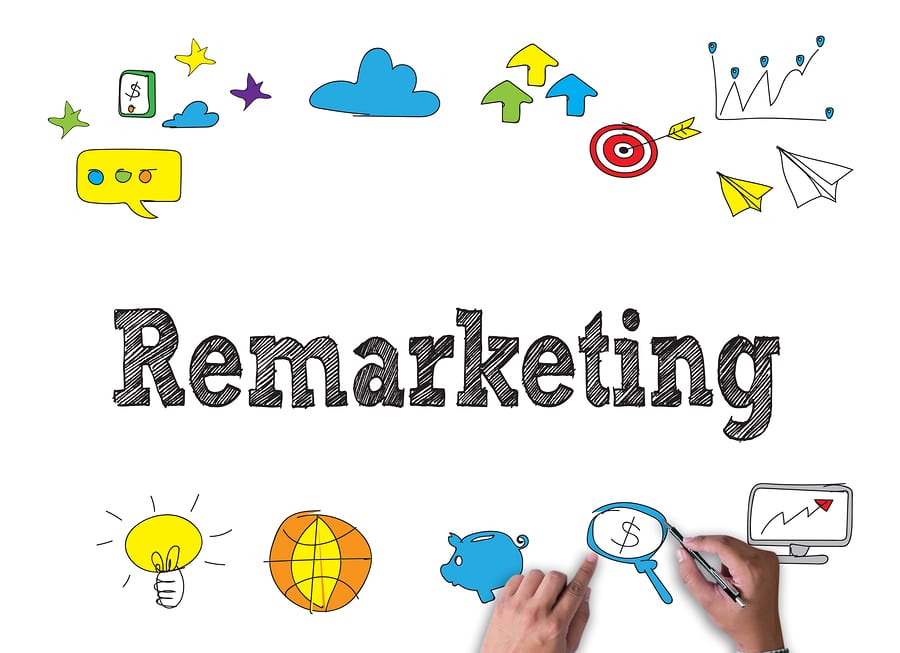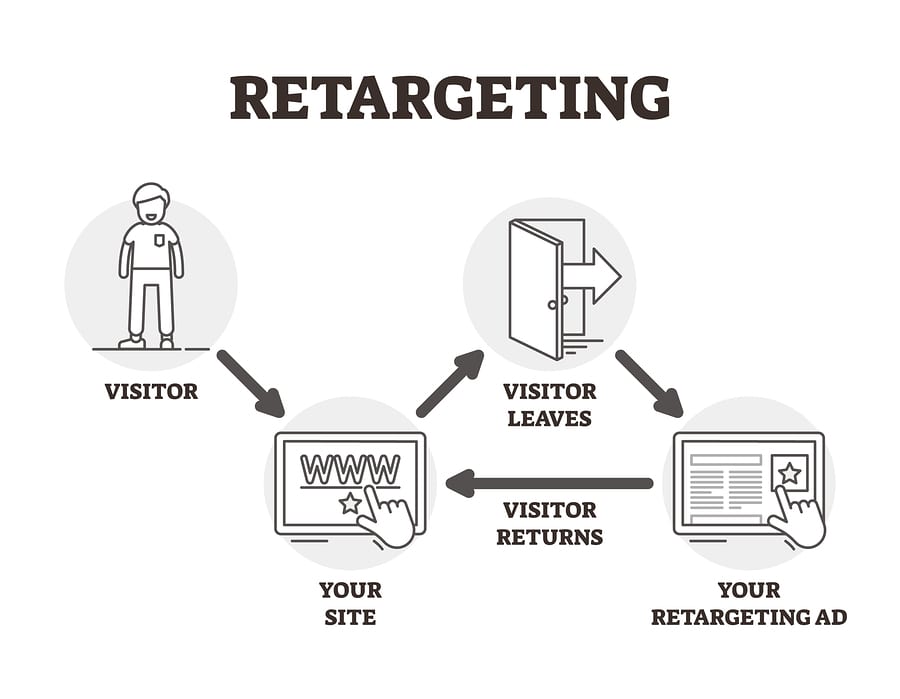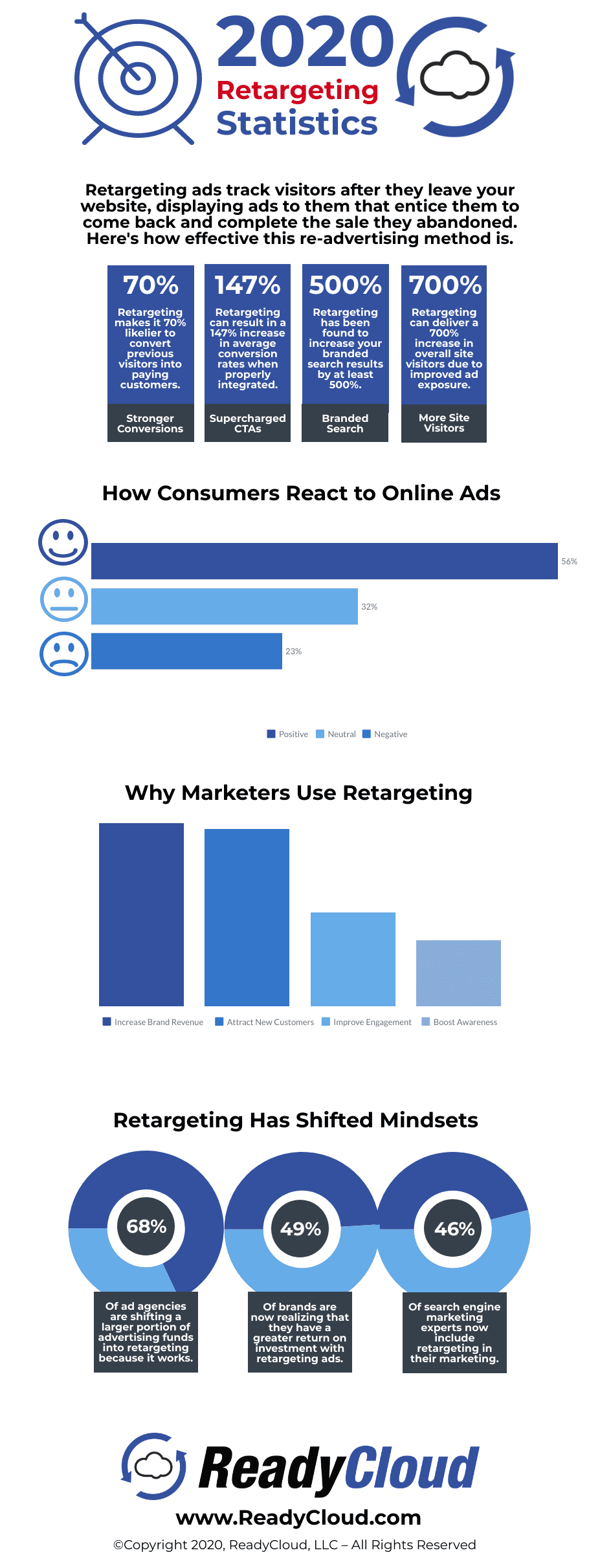Use These Awesome Remarketing Facts to Power Your Reach in 2020

Remarketing is the key to a hassle-free marketing strategy. With remarketing, you can bring back the consumers who bounced from your online store and turn them into customers. It requires little setup, but you reap the rewards for long afterward.
Read on to learn more.
What Is Remarketing?
Remarketing, also called retargeting, is the name for re-engaging website visitors and convincing them to return to your online store. (In the past, remarketing referred to using email while retargeting referred to using display ads, but now the two terms are interchangeable.)
It keeps your brand top-of-mind for consumers as they browse the web so there are numerous chances for them to enter the sales funnel. Moreover, if gives you second and sometimes third chances to win over sales from undecided shoppers.
How Remarketing Works
How does retargeting work? Here’s a quick breakdown to help you better understand:
- After online shoppers have left your site, remarketing kicks in via a retargeting pixel, website code snippet or JavaScript tag. Display ads then follow them around and appear on other sites and in social media feeds to remind them of your brand and the items they were viewing.
- You can also show them related items or products you think they’d be interested in based on their browsing activity. Alternatively, you can show them a non-product display ad that showcases your company’s mission or a captivating piece of your brand story.
- If you captured an email address via a “Welcome” pop up or during checkout, you can also send a reminder to come back and shop. Recovery emails are one of the top strategies to tackle cart abandonment, so you can hit two birds with one stone.
 Now that you know the basics, here are some awesome remarketing facts to power your reach in 2020.
Now that you know the basics, here are some awesome remarketing facts to power your reach in 2020.
Consumers Like Retargeting Ads
Consumers rarely complete a purchase the first time they visit an online store. That’s no fault of your own but rather the way of the ecommerce world. After that first visit, however, shoppers may want to be reminded of the products they were looking at while browsing.
A report by Adobe research has found 25% of online shoppers enjoy retargeted ads, and 60% have neutral feelings. Only 11% are averse to the practice, so the odds are in your favor that consumers won’t mind seeing the ads. Be mindful that it’s easy to go overboard with retargeted ad placements, and sentiment can quickly turn sour.
Remarketing Improves Conversions
Remember how almost all visitors to your website will leave before buying something? The bright side of this conundrum is that you get plenty of opportunity for remarketing. By showing retargeted ads to all these shoppers, you repeatedly nudge them toward your brand.
A report by Critero researchers discovered consumers who see retargeted ads will buy from that brand (versus a competitor) 70% of the time, so it’s a proven tactic to edge out the competition. Ultimately this boosts conversions and your bottom line.
Retargeted Ads Get Noticed
A lot of e-tailers are unaware that more than half (60%) of customers will actually notice and consider retargeted ads. They’ve already expressed interest in what they see in the ads, so what caught their eye once surely will do so again and lead them back to your online store.
Retargeted Ads Get Lots of Clicks
Ad engagement is one of the key performance indicators that marketers track, and they’ve found that retargeted ads do far better than their standard counterparts. Specifically, the click-through rate (CTR) of display ads is a measly 0.07% whereas the CTR of retargeted ads is 0.7%.
This shows a strong consumer preference for customized advertising. It also hints that remarketing as a strategy for improving conversions is 10x more effective than your typical display ads.
Remarketing is Effective
There’s no doubt that remarketing is effective, and expert findings can back it up. The Interactive Advertising Bureau (IAB) surveyed 1000 marketing professionals in regards to remarketing, and the findings were telling. Of the respondents, 92% said retargeting performs at the same level or better than search marketing, 91% said the same for email marketing and 92% agreed for display advertising.
This proves it’s a powerful tactic in the same league as the strategy’s marketers have been using for decades.
Remarketing Increases Name Searches
In a recent comScore study 103 marketing campaigns from 39 different advertisers across seven industries were analyzed, and had some significant findings about remarketing.
Retargeted ads were more effective than any other ad placement strategy. They performed better than audience targeting by 514%, contextual targeting by 130%, efficiency pricing by 100%, premium pricing by 300% and run-of-network (RON) by 126%.
The most startling result: Remarketing lifted business name searches by 1046%. This is yet another set of statistics proving remarketing’s effectiveness.
Most Brands Have a Remarketing Budget
Brands and agencies are starting to pick up on the powerful tactic that is remarketing. Per Incite Group data, 68% of digital marketing agencies and 49% of brands have set aside a dedicated remarketing budget.
This is way up from 2013, when only 20% of marketers considered remarketing worth their while and budgeted for it. Now, digital marketers are spending 41% of their paid display ad budgets on retargeting.
Brand Awareness Is the Top Goal
When confronted with an unfamiliar brand, most online shoppers will not remember its name or what was being sold unless a product stood out. It takes multiple occasions of seeing that brand to solidify its place in their memory.
That’s the gist of remarketing, according to marketing professionals across B2B and B2C brands surveyed by the IAB. Increasing brand awareness is the top objective, with 70% giving this answer. Social engagement (62%) and driving sales (58%) were other notable goals of remarketing.
It’s a Go-To for Ecommerce
Remarketing got its start in retail/ecommerce, where conversion rates have always been low. Sellers needed (and still need) to find a way to bring prospective customers back to their websites.
Remarketing is still a go-to for e-tailers and online brands, but it has been adopted by other industries as well. IAB research reveals 17% of media, 10% of tech and healthcare, 9% of finance, 8% of education/government and 5% of travel companies now reap the rewards of remarketing.
SEO Experts Think Remarketing is Underused
It isn’t easy to adopt a new marketing strategy, even one that has proven to be effective. The larger the company, the more people must approve the idea before it can be implemented. This is what is stopping ecommerce marketers from using retargeting to drive sales and improve conversions.
Remarketing is on the rise, yes, but 46% of search engine specialists say the tactic is underused.
Shoppers Will Sacrifice Privacy for a Deal
Online protection and privacy are constantly up for debate, but American shoppers are willing to ditch both in the name of the almighty dollar. Per a study from the Pew Research Center, 47% of respondents would be comfortable having their online shopping activity tracked if it can get them better deals.
These study results reveal that consumers address privacy concerns on a case-by-case basis, and they don’t find it invasive if e-tailers track their browsing activity. This bodes well for ecommerce marketers who want to remarket to unconverted consumers. Nearly half of them would be fine with retargeted ads.
Marketers Are Increasing Remarketing Budgets
It seems that the search engine specialists were heard when they lamented that remarketing is underused. Invespcro reports 50% of marketers plan to increase their remarketing budgets in the next six months.
You still have time to get ahead of the competition but be sure to do so as soon as possible.
It Brings Back Cart Abandoners
A recent batch of retargeting statistics reveals that of the 72% of customers who abandon their carts, only 8% come back to make a purchase without remarketing.
Serving retargeted ads brings these cart abandoners back to your site so you can finally make the sale. With this tactic, your conversion rate rises to 26%. How’s that for a foolproof method?
Mobile Remarketing Really Works
As you can see, the remarketing trend has caught on, but many marketers are still averse to retargeting on mobile. This can give you a major edge. Many ecommerce marketing professionals don’t want to use mobile retargeting because they don’t have an app (34%) or a mobile site (27%) that will provide the most seamless shopping experience.
But the mobile commerce revolution is in full swing in 2020, so even adding a mobile site will help your conversion rate. Other reasons marketers avoid mobile retargeting are they don’t like mobile ad user experience (24%) or, for some reason, don’t believe their customers are mobile (13%).
Ad Engagement Goes Through the Roof
We already explained how retargeted ads perform 10x better than standard display ads in terms of click-through rate. What we didn’t describe is how remarketing lifts ad engagement.
Kenshoo reports that brands that use retargeted ads can see a 400% uplift in total ad engagement.
Brand Awareness Is the Top Goal
When confronted with an unfamiliar brand, most online shoppers will not remember its name or what was being sold unless a product stood out. It takes multiple occasions of seeing that brand to solidify its place in their memory.
That’s the gist of remarketing, according to marketing professionals across B2B and B2C brands surveyed by the IAB. Increasing brand awareness is the top objective, with 70% giving this answer. Social engagement (62%) and driving sales (58%) were other notable goals of remarketing.
Shoppers Want Personalized Ads
It’s true, personalization is everything in today’s ecommerce world. Consumers don’t speak with anyone while shopping online, so there is no person-to-person interaction that fosters brand connection. It can seem, to shoppers, like they’re not being cared for.
Here is where personalization comes into play. Small tweaks like addressing a shopper by name in an email result in more email opens, click throughs and purchases. The same concept applies to ads. If consumers feel like the ad has been presented specifically for them, they’ll feel more connected to it.
This explains why 78% of online shoppers believe “personally appropriate content from brands” enhances their purchase intent. Simply put, retargeted ads feel personalized and are more likely to drive a purchase.
Email Remarketing Works
Haven’t you heard? Email marketing is cool again. It’s a direct line to customers and prospects who have expressed interest in your brand by subscribing to your marketing messages.
Additionally, it’s a way to convince shoppers to come back and buy—and it works. A recent study found 41% of cart abandonment emails are opened, and roughly 30% of the click-throughs lead to a purchase. If you captured a shopper’s email, remarketing will be a breeze.
Why You Should Consider Remarketing
If you’re not yet convinced of the power of remarketing, consider this: Online shoppers, on average, visit a site 9.5 times before completing a purchase. That is 9+ opportunities for your competitors to sway them away from your store.
Retargeted ads simply keep the competition at bay and solidify your brand as the top choice by subtly pushing shoppers toward your website time and time again. There are dozens, if not hundreds, of other sites selling the same products as you do, so remarketing is more important than ever.
Don’t let online shoppers get away, never to return. Reel them back in with remarketing and enjoy the supercharged conversion rate.
The Case for Retargeting
Regardless of your industry and goals, retargeting is an effective and engaging way to boost your conversions, earn more customers, and bring back consumers who have shopped with you before. In addition to being effective, retargeting is also flexible, which means you can use it to create pretty much any outcome you want.
Need even more info? Check this infographic we’ve created. Feel free to upload it to your site and to share it on social media.

What You Should Do Now
Here are 3 ways ReadyReturns can help you deliver amazing return experiences that eliminate prepaid labels and boxes, delight customers, and protect your margins:
Schedule a Demo – See how ReadyReturns turns product returns into your competitive advantage with “Amazon-like” returns and cost-saving features.
Start Your Free Trial of ReadyReturns (No CC Required) – Set up in minutes. Instantly offer QR code returns, product exchanges, and custom return rules that turn frustrated customers into repeat buyers.
Try ReadyCloud at No Cost – Why manage shipping and returns separately? Get ReadyShipper X, ReadyReturns, and more in one unified platform for seamless fulfillment and order management.
Share On:









